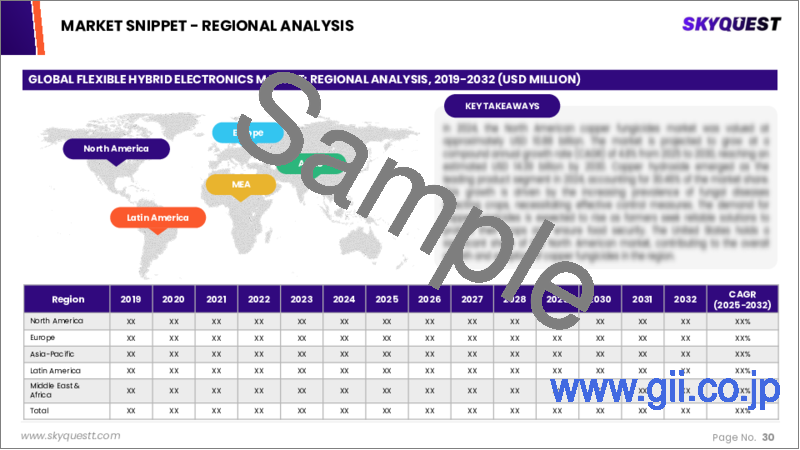|
|
市場調査レポート
商品コード
1670159
フレキシブル・ハイブリッド・エレクトロニクスの市場規模、シェア、成長分析:材料別、基板別、製造工程別、用途別、地域別 - 産業予測 2025~2032年Flexible Hybrid Electronics Market Size, Share, and Growth Analysis, By Material, By Substrates (Device Type, Thin Film Transistors ), By Manufacturing Process, By Application, By Region - Industry Forecast 2025-2032 |
||||||
|
|||||||
| フレキシブル・ハイブリッド・エレクトロニクスの市場規模、シェア、成長分析:材料別、基板別、製造工程別、用途別、地域別 - 産業予測 2025~2032年 |
|
出版日: 2025年02月28日
発行: SkyQuest
ページ情報: 英文 191 Pages
納期: 3~5営業日
|
全表示
- 概要
- 目次
フレキシブル・ハイブリッド・エレクトロニクスの世界市場規模は、2023年に2億3,252万米ドルとなり、2024年の2億7,530万米ドルから2032年には10億6,323万米ドルに成長し、予測期間(2025年~2032年)のCAGRは18.4%で成長する見通しです。
フレキシブル・ハイブリッド・エレクトロニクス市場は、ウェアラブルデバイスの需要増とモノのインターネット(IoT)およびコネクテッドテクノロジーの普及に牽引され、大きく成長する見通しです。革新的なフレキシブル・エレクトロニクスへの世界の投資と、導電性インクや伸縮性ポリマーなどの材料の進歩が相まって、市場の見通しが強化されようとしています。スクリーン印刷や3D印刷を含む最先端の印刷法は、特にヘルスケアやコンシューマー・エレクトロニクスの分野で応用範囲を広げています。しかし、標準化の欠如、高い開発コスト、統合の複雑さ、過酷な環境下での耐久性の問題などの課題が、普及の妨げになる可能性があります。全体として、これらの動向は、今後数年間の市場情勢がダイナミックであることを示しています。
目次
イントロダクション
- 調査の目的
- 調査範囲
- 定義
調査手法
- 情報調達
- 二次と一次データの方法
- 市場規模予測
- 市場の前提条件と制限
エグゼクティブサマリー
- 世界市場の見通し
- 供給と需要の動向分析
- セグメント別機会分析
市場力学と見通し
- 市場概要
- 市場規模
- 市場力学
- 促進要因と機会
- 抑制要因と課題
- ポーターの分析
主な市場の考察
- 重要成功要因
- 競合の程度
- 主な投資機会
- 市場エコシステム
- 市場の魅力指数(2024年)
- PESTEL分析
- マクロ経済指標
- バリューチェーン分析
- 価格分析
- 技術の進歩
フレキシブル・ハイブリッド・エレクトロニクス市場規模:材料別
- 市場概要
- 有機半導体
- 無機半導体
- 誘電体材料
- 導電性材料
フレキシブル・ハイブリッド・エレクトロニクス市場規模:基板別
- 市場概要
- デバイスタイプ
- 薄膜トランジスタ(TFT)
- 発光ダイオード(LED)
- 太陽電池
- センサー
- アンテナ
フレキシブル・ハイブリッド・エレクトロニクス市場規模:製造工程別
- 市場概要
- ロールツーロール印刷
- インクジェット印刷
- スパッタリング
- スピンコーティング
- 原子層堆積法(ALD)
フレキシブル・ハイブリッド・エレクトロニクス市場規模:用途別
- 市場概要
- ウェアラブルエレクトロニクス
- ヘルスケアおよび医療機器
- 家電
- 自動車
- 産業
フレキシブル・ハイブリッド・エレクトロニクス市場規模
- 北米
- 米国
- カナダ
- 欧州
- ドイツ
- スペイン
- フランス
- 英国
- イタリア
- その他欧州地域
- アジア太平洋地域
- 中国
- インド
- 日本
- 韓国
- その他アジア太平洋地域
- ラテンアメリカ
- ブラジル
- その他ラテンアメリカ地域
- 中東・アフリカ
- GCC諸国
- 南アフリカ
- その他中東・アフリカ
競合情報
- 上位5社の比較
- 主要企業の市場ポジショニング(2024年)
- 主な市場企業が採用した戦略
- 最近の市場動向
- 企業の市場シェア分析(2024年)
- 主要企業の企業プロファイル
- 企業の詳細
- 製品ポートフォリオ分析
- 企業のセグメント別シェア分析
- 収益の前年比比較(2022~2024年)
主要企業プロファイル
- Samsung Electronics(South Korea)
- LG Electronics(South Korea)
- Panasonic Corporation(Japan)
- 3M Company(United States)
- Konica Minolta Inc.(Japan)
- First Solar, Inc.(United States)
- E Ink Holdings(Taiwan)
- PragmatIC Printing Ltd.(United Kingdom)
- Blue Spark Technologies, Inc.(United States)
- BrightVolt Technologies(United States)
- DuPont Teijin Films(United States)
- PARC(Xerox Corporation)(United States)
- General Electric Company(United States)
- Lockheed Martin Corporation(United States)
- Flex Ltd.(Singapore)
- Brewer Science Inc.(United States)
- SI2 Technologies Inc.(United States)
- BOE Technology Group(China)
- AU Optronics Corp.(Taiwan)
- Cymbet Corporation(United States)
結論と提言
Global Flexible Hybrid Electronics Market size was valued at USD 232.52 million in 2023 and is poised to grow from USD 275.3 million in 2024 to USD 1063.23 million by 2032, growing at a CAGR of 18.4% during the forecast period (2025-2032).
The market for flexible hybrid electronics is poised for significant growth, driven by the rising demand for wearable devices and the proliferation of the Internet of Things (IoT) and connected technologies. Global investments in innovative flexible electronics, coupled with advancements in materials like conductive inks and stretchable polymers, are set to enhance market prospects. Cutting-edge printing methods, including screen and 3D printing, are broadening application scopes, particularly in healthcare and consumer electronics. However, challenges such as a lack of standardization, high development costs, integration complexities, and durability issues in harsh environments may hinder adoption. Overall, these trends indicate a dynamic market landscape for flexible hybrid electronics in the coming years.
Top-down and bottom-up approaches were used to estimate and validate the size of the Global Flexible Hybrid Electronics market and to estimate the size of various other dependent submarkets. The research methodology used to estimate the market size includes the following details: The key players in the market were identified through secondary research, and their market shares in the respective regions were determined through primary and secondary research. This entire procedure includes the study of the annual and financial reports of the top market players and extensive interviews for key insights from industry leaders such as CEOs, VPs, directors, and marketing executives. All percentage shares split, and breakdowns were determined using secondary sources and verified through Primary sources. All possible parameters that affect the markets covered in this research study have been accounted for, viewed in extensive detail, verified through primary research, and analyzed to get the final quantitative and qualitative data.
Global Flexible Hybrid Electronics Market Segments Analysis
Global Flexible Hybrid Electronics Market is segmented by Material, Substrates, Manufacturing Process, Application and region. Based on Material, the market is segmented into Organic Semiconductors, Inorganic Semiconductors, Dielectric Materials and Conductive Materials. Based on Substrates, the market is segmented into Device Type, Thin Film Transistors (TFTs), Light-Emitting Diodes (LEDs), Solar Cells, Sensors and Antennas. Based on Manufacturing Process, the market is segmented into Roll-to-Roll Printing, Inkjet Printing, Sputtering, Spin Coating and Atomic Layer Deposition (ALD). Based on Application, the market is segmented into Wearable Electronics, Healthcare and Medical Devices, Consumer Electronics, Automotive and Industrial. Based on region, the market is segmented into North America, Europe, Asia Pacific, Latin America and Middle East & Africa.
Driver of the Global Flexible Hybrid Electronics Market
The global flexible hybrid electronics market is poised for substantial growth, largely fueled by the rising demand for wearable devices and technologies. The increasing adoption of fitness trackers, smartwatches, and medical wearables around the globe is anticipated to significantly enhance market prospects. These flexible hybrid electronics are essential in creating lightweight and comfortable wearables, which are becoming increasingly popular among consumers. As the trend towards health and fitness continues to gain momentum, the need for advanced electronic solutions that support these devices will drive sales and innovation within the flexible hybrid electronics sector in the coming years.
Restraints in the Global Flexible Hybrid Electronics Market
The Global Flexible Hybrid Electronics market faces significant challenges that may hinder its growth. The development and manufacturing of these advanced electronics are complex tasks that demand considerable capital and resource commitments. The necessity for sophisticated materials, elaborate design methodologies, and specialized machinery contributes to the high costs associated with flexible hybrid electronics. As a result, these elevated expenses can restrict the market's long-term development potential, making it increasingly difficult for companies to invest in innovation and scalability. Consequently, the financial barriers associated with entering and thriving in this market may deter new participants and limit overall market expansion.
Market Trends of the Global Flexible Hybrid Electronics Market
The Global Flexible Hybrid Electronics market is witnessing a significant shift towards smart packaging solutions, driven by an increasing demand for enhanced functionality and interactivity in packaging. Companies in this sector are strategically targeting the packaging industry, leveraging flexible hybrid technologies to provide real-time monitoring capabilities, such as temperature tracking for perishable goods and interactive features to bolster consumer engagement. This trend not only enables brands to ensure product integrity and reduce waste but also enhances the overall consumer experience, presenting a lucrative opportunity for businesses aiming to capture market share and maximize revenue in an evolving packaging landscape.
Table of Contents
Introduction
- Objectives of the Study
- Scope of the Report
- Definitions
Research Methodology
- Information Procurement
- Secondary & Primary Data Methods
- Market Size Estimation
- Market Assumptions & Limitations
Executive Summary
- Global Market Outlook
- Supply & Demand Trend Analysis
- Segmental Opportunity Analysis
Market Dynamics & Outlook
- Market Overview
- Market Size
- Market Dynamics
- Drivers & Opportunities
- Restraints & Challenges
- Porters Analysis
- Competitive rivalry
- Threat of substitute
- Bargaining power of buyers
- Threat of new entrants
- Bargaining power of suppliers
Key Market Insights
- Key Success Factors
- Degree of Competition
- Top Investment Pockets
- Market Ecosystem
- Market Attractiveness Index, 2024
- PESTEL Analysis
- Macro-Economic Indicators
- Value Chain Analysis
- Pricing Analysis
- Technological Advancement
Global Flexible Hybrid Electronics Market Size by Material & CAGR (2025-2032)
- Market Overview
- Organic Semiconductors
- Inorganic Semiconductors
- Dielectric Materials
- Conductive Materials
Global Flexible Hybrid Electronics Market Size by Substrates & CAGR (2025-2032)
- Market Overview
- Device Type
- Thin Film Transistors (TFTs)
- Light-Emitting Diodes (LEDs)
- Solar Cells
- Sensors
- Antennas
Global Flexible Hybrid Electronics Market Size by Manufacturing Process & CAGR (2025-2032)
- Market Overview
- Roll-to-Roll Printing
- Inkjet Printing
- Sputtering
- Spin Coating
- Atomic Layer Deposition (ALD)
Global Flexible Hybrid Electronics Market Size by Application & CAGR (2025-2032)
- Market Overview
- Wearable Electronics
- Healthcare and Medical Devices
- Consumer Electronics
- Automotive
- Industrial
Global Flexible Hybrid Electronics Market Size & CAGR (2025-2032)
- North America (Material, Substrates, Manufacturing Process, Application)
- US
- Canada
- Europe (Material, Substrates, Manufacturing Process, Application)
- Germany
- Spain
- France
- UK
- Italy
- Rest of Europe
- Asia Pacific (Material, Substrates, Manufacturing Process, Application)
- China
- India
- Japan
- South Korea
- Rest of Asia-Pacific
- Latin America (Material, Substrates, Manufacturing Process, Application)
- Brazil
- Rest of Latin America
- Middle East & Africa (Material, Substrates, Manufacturing Process, Application)
- GCC Countries
- South Africa
- Rest of Middle East & Africa
Competitive Intelligence
- Top 5 Player Comparison
- Market Positioning of Key Players, 2024
- Strategies Adopted by Key Market Players
- Recent Developments in the Market
- Company Market Share Analysis, 2024
- Company Profiles of All Key Players
- Company Details
- Product Portfolio Analysis
- Company's Segmental Share Analysis
- Revenue Y-O-Y Comparison (2022-2024)
Key Company Profiles
- Samsung Electronics (South Korea)
- Company Overview
- Business Segment Overview
- Financial Updates
- Key Developments
- LG Electronics (South Korea)
- Company Overview
- Business Segment Overview
- Financial Updates
- Key Developments
- Panasonic Corporation (Japan)
- Company Overview
- Business Segment Overview
- Financial Updates
- Key Developments
- 3M Company (United States)
- Company Overview
- Business Segment Overview
- Financial Updates
- Key Developments
- Konica Minolta Inc. (Japan)
- Company Overview
- Business Segment Overview
- Financial Updates
- Key Developments
- First Solar, Inc. (United States)
- Company Overview
- Business Segment Overview
- Financial Updates
- Key Developments
- E Ink Holdings (Taiwan)
- Company Overview
- Business Segment Overview
- Financial Updates
- Key Developments
- PragmatIC Printing Ltd. (United Kingdom)
- Company Overview
- Business Segment Overview
- Financial Updates
- Key Developments
- Blue Spark Technologies, Inc. (United States)
- Company Overview
- Business Segment Overview
- Financial Updates
- Key Developments
- BrightVolt Technologies (United States)
- Company Overview
- Business Segment Overview
- Financial Updates
- Key Developments
- DuPont Teijin Films (United States)
- Company Overview
- Business Segment Overview
- Financial Updates
- Key Developments
- PARC (Xerox Corporation) (United States)
- Company Overview
- Business Segment Overview
- Financial Updates
- Key Developments
- General Electric Company (United States)
- Company Overview
- Business Segment Overview
- Financial Updates
- Key Developments
- Lockheed Martin Corporation (United States)
- Company Overview
- Business Segment Overview
- Financial Updates
- Key Developments
- Flex Ltd. (Singapore)
- Company Overview
- Business Segment Overview
- Financial Updates
- Key Developments
- Brewer Science Inc. (United States)
- Company Overview
- Business Segment Overview
- Financial Updates
- Key Developments
- SI2 Technologies Inc. (United States)
- Company Overview
- Business Segment Overview
- Financial Updates
- Key Developments
- BOE Technology Group (China)
- Company Overview
- Business Segment Overview
- Financial Updates
- Key Developments
- AU Optronics Corp. (Taiwan)
- Company Overview
- Business Segment Overview
- Financial Updates
- Key Developments
- Cymbet Corporation (United States)
- Company Overview
- Business Segment Overview
- Financial Updates
- Key Developments





